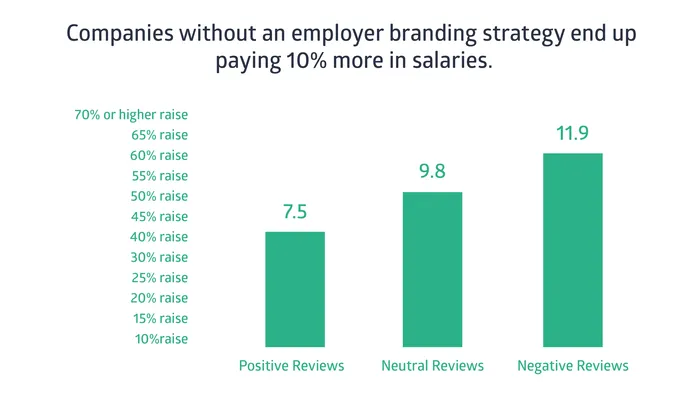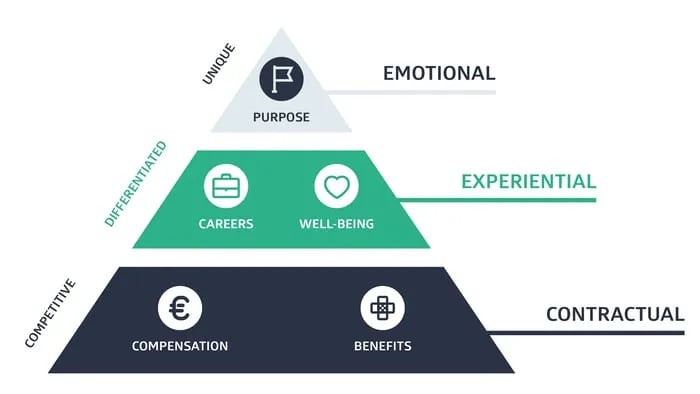7 Tips to Build your Employer Branding Strategy

As important as the war for each and every customer is today, companies are becoming increasingly aware that there’s an equally important battle underway on the market - a battle for great employees. Driven employees are essential for your company’s success, and you get to be the one to hire them by working on your employer brand and becoming a company they want to work for. To become that, you need to focus your employee advocacy efforts on developing an employer branding strategy that works.
As important as the war for each and every customer is today, companies are becoming increasingly aware that there’s an equally important battle underway on the market — a battle for great employees. Without them, their war for customers is all but lost.
Great, driven employees are essential for your company’s success, and you get to be the one to hire them by working on your employer brand and becoming the company they want to work for. To become that, you need to focus your employee advocacy efforts on developing an employer branding strategy that works.
Get in touch if you wanna find out more about installing advocacy
Talk to our experts
But, let's take it one step at a time. You’re probably wondering what an employer brand is, exactly, right?
In a nutshell, the term “employer brand” describes the popularity and reputation that your company enjoys with its current and potential employees. The way your company is perceived on the outside.
Additionally, “employer branding” is a set of actions and processes through which you position yourself as a top-of-mind employer, thus attracting the talent you're looking to hire. This is done through the fundamental (re)consideration of your company’s mission, values, communication, culture, and compensation and benefits packages — they all need to be aligned with what the top talent on the market expects and looks for in order to be effective.
Employer branding statistics that matter

The corporate world has changed. Potential employees have a lot more choices today, and HR departments around the globe are struggling to make their companies relevant in this evolving context. Here are some interesting statistics that illustrate why having a strong employer brand is essential today.
- 92% of employees will consider leaving if they are offered a job in a company with a better reputation (Corporate Responsibility Magazine, September 2015), and 50% won’t even consider working for you if your bad online reputation precedes you — even if you offer them more money1.
Social and professional networks are ranked as top potential resources for job search, outdoing job boards, ads, and recruiting agencies and events. If your company doesn’t have a strong, calculated presence on social media sites, the chances are that the best employees will never even hear about you.
- Companies with a strong employer brand have a 43% lower cost per hire. That’s because they have built a supporting structure for their hiring process; educated recruiters, employee advocates, a master in leveraging professional and social online networks, and so on.
- Candidates trust employees 3X more than they trust anything that the company puts out3. You can say whatever you like in your job ads and on your company’s website, but candidates will sniff out the truth by actively searching out your former and current employees on sites such as Glassdoor, where they might learn the things you don’t want them to know.
A very strong case can be made for investing in employer branding, but before tackling it, though, you have to think about the candidates you want to attract, as well as what you have to offer to them — this will form the basis of your employee value proposition.
1. Develop a strong employee value proposition

When candidates hunt for a job, they ask themselves a number of questions that are not limited to just the salary amount. More often than not, they will have questions about the benefits, work culture, colleagues, internal support systems, and more. How a company communicates those things forms the basis of its employer brand and can make a strong employee value proposition.
An EVP communicates the total value your employees get for their work. Ideally, it will be a succinct document that lays everything out in a clear manner, although most companies have a really short, sometimes even sentence-long version that they market and share externally.
Here are some of the steps that you will need to consider when developing an EVP:
- Define your ideal candidate: who they are, what they do, and how they do it. Where are they working now? What are the things that they value the most.
- Define what you’re offering: you should write down what your employees are getting in return for their work. Benefits? Opportunities for growth? Paid vacation? Flexible working hours? Put it all down on paper and see what you need to work on to attract your ideal candidates.
If you're not sure how you're currently doing with your standard offering, talk to your current employees of mind out. You need to be aware of how people perceive your company, even at the cost of admitting there are big steps to take in front of you. Use their answers to plan how to update what you offer going forward.
- Communicate your values and your purpose: contractually, you are obligated to offer compensation and benefits, and one assumes you're also taking care that your employees are feeling safe and happy in your work environment. However, what sets you apart from your competitors is your company’s mission: make sure to tell potential candidates how you’re making a difference, and how much their contribution will help you to continue doing that.
- Condense your EVP into a sentence: even if you have pages of documentation, you should strive to present your EVP clearly and concisely. That small paragraph needs to capture the spirit of what it’s like to work for you.
Here’s how the pros do it:
“We’re building a company people love. A company that will stand the test of time, so we invest in our people and optimize for your long-term happiness.” – Hubspot
“We lead. We invent. We deliver. We use the power of sport to move the world.” – Nike
“Do cool things that matter.” – Google
2. Assign ownership of your employer branding strategy wisely
As mentioned, employer branding is only successful when it's lived across all levels and departments of your company. This means that different departments need to be involved in creating the strategy and that every employee needs to be aware of it.
Don’t be afraid to hire outside help if you need to, especially at the start when you’re forming a team that will take ownership of your employer branding strategy.
3. Educate current employees about your employer branding efforts
Not communicating your employer branding strategy with your current employees would be a huge mistake. How can they help you refine it if they don’t know it exists? How can they spread the word if they don’t know they should? You want your communication going toward the hiring pool to be consistent so you need everyone in your company to be on the same page when it comes to compensation, benefits, culture, and other messages.
The best way to do this is to bring new employees into the loop during the onboarding period. Also, make sure to share regular updates to keep current employees informed. Employee advocacy platforms, such as Ambassify, can be used to schedule occasional emails to remind employees about open positions, company review possibilities, and more.
Talk to our experts to find the best solution for your business
Book your 1-on-1 demo
4. Own & manage your online reputation with your employee advocates
A lot of what you as a company have to say will be taken with a grain of salt by candidates. That's why many candidate will do their own online research into your company’s culture and how you treat your employees.
That means that you should be devoting a lot of attention to first nurturing your relationship with your current employees. The Ambassify platform is a great place to issue regular calls to your employees, and invite them to spread the word about just how great of an employer you really are.
By using Ambassify, you know exactly which employees participated and can reward their efforts. And, for those who didn’t participate, you can change your approach and try from a different angle.
5. Use storytelling to communicate employee stories that have an impact
Digital storytelling is extremely important when building an employer brand, and how well you do it will often be the only thing that separates you from your competitors.
Storytelling is all about how you communicate the information you want potential candidates to know, generally in a manner that draws them in deeper and makes them want to learn more about you.
To do a good job with storytelling, use employee stories to address any questions that the candidates might have. Have a current employee tell their story about how the ability to work flexible hours impacts them, for example — they get to drop off their kids at school and pick up breakfast before heading into the office. And with an employee advocacy platform like Ambassify, you could schedule employee emails well in advance, adding links to the stories and inviting people to spread the word far and wide.
6. Build an incentivized employee referral program
While it’s not always necessary to offer monetary compensation for employee referrals, large corporations such as Google are seeing great returns with it. In addition to providing an opportunity for employees to earn a bit extra by recommending a qualified candidate, it also gives them a chance to compete with colleagues (keeping a tally of hires internally), or to maybe bring a friend to the company fold.
The Ambassify platform has an employee referral module that lets you activate your current employees whenever there’s an opening in the company. The module allows them to share open positions on social networks, and it allows you to track who was referred, by whom, when, for which position, and was that person ultimately hired.
.webp?width=700&height=394&name=affiliate-final%20(1).webp)
7. Choose employer branding metrics that matter
Make sure to measure the success of your efforts to see if your employer branding strategy is yielding the results you want. The metrics you will focus on will become clear once you speak to your HR and marketing departments, but here are just a few that you should be focusing on:
- Retention rates. Have they gone up or down since the deployment of the program?
- Employee engagement. Regular surveys should give clear enough insight into how employees perceive your employer branding efforts. Are they participating?
- Quality of candidates. How is the ratio of interviews to hires? Are new employees coming with better soft skills? Do they adapt more easily? Is the onboarding process shorter? Your HR department will be able to figure out a simple system to measure things in this particular category.
- Cost of hire. How much money do you now spend during the hiring process as opposed to when you didn’t have a formalized employer branding strategy? Sum up the fees, advertising, testing, and interview time - if the total number is down, you’re doing something right!
- Brand awareness. Specifically, brand awareness as it relates to the recruitment process. Are people coming in more informed about your company? Are you getting out-of-the-blue calls even when you’re not advertising an open position? Are your site’s ‘Open Positions’ pages getting more visitors?
- The pipeline. In the past, most candidates came to you via career and recruitment sites. You might find that this changes once you start working on your employer brand - slowly, more and more candidates will start contacting you directly, either through email or social media sites.
Use Ambassify to power up your employer branding efforts
The times are gone when you could completely disregard your company’s image and reputation, and still be reasonably certain that you will be able to fill your ranks with qualified and competent employees. Around 86% of recruiters and 62% of employers feel that ours is a candidate-driven market.
Ambassify can help you harness the power of your current employees, turning them into employee advocates, and encouraging them to share their personal stories with their networks. We have helped dozens of companies like yours to step up their employer branding efforts, and we’re ready to work with you toward achieving your specific goals.